Tat protein induces human immunodeficiency virus type 1 (HIV-1) coreceptors and promotes infection with both macrophage-tropic and T-lymphotropic HIV-1 strains
- PMID: 9765440
- PMCID: PMC110312
- DOI: 10.1128/JVI.72.11.8952-8960.1998
Tat protein induces human immunodeficiency virus type 1 (HIV-1) coreceptors and promotes infection with both macrophage-tropic and T-lymphotropic HIV-1 strains
Abstract
Chemokine receptors CCR5 and CXCR4 are the primary fusion coreceptors utilized for CD4-mediated entry by macrophage (M)- and T-cell line (T)-tropic human immunodeficiency virus type 1 (HIV-1) strains, respectively. Here we demonstrate that HIV-1 Tat protein, a potent viral transactivator shown to be released as a soluble protein by infected cells, differentially induced CXCR4 and CCR5 expression in peripheral blood mononuclear cells. CCR3, a less frequently used coreceptor for certain M-tropic strains, was also induced. CXCR4 was induced on both lymphocytes and monocytes/macrophages, whereas CCR5 and CCR3 were induced on monocytes/macrophages but not on lymphocytes. The pattern of chemokine receptor induction by Tat was distinct from that by phytohemagglutinin. Moreover, Tat-induced CXCR4 and CCR5 expression was dose dependent. Monocytes/macrophages were more susceptible to Tat-mediated induction of CXCR4 and CCR5 than lymphocytes, and CCR5 was more readily induced than CXCR4. The concentrations of Tat effective in inducing CXCR4 and CCR5 expression were within the picomolar range and close to the range of extracellular Tat observed in sera from HIV-1-infected individuals. The induction of CCR5 and CXCR4 expression correlated with Tat-enhanced infectivity of M- and T-tropic viruses, respectively. Taken together, our results define a novel role for Tat in HIV-1 pathogenesis that promotes the infectivity of both M- and T-tropic HIV-1 strains in primary human leukocytes, notably in monocytes/macrophages.
Figures

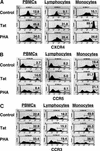

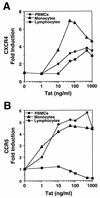

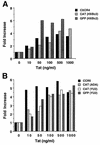
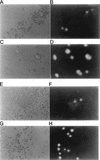
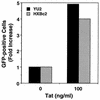
Similar articles
-
Lineage-specific expression of human immunodeficiency virus (HIV) receptor/coreceptors in differentiating hematopoietic precursors: correlation with susceptibility to T- and M-tropic HIV and chemokine-mediated HIV resistance.Blood. 1999 Sep 1;94(5):1590-600. Blood. 1999. PMID: 10477684
-
Role of CXCR4 in cell-cell fusion and infection of monocyte-derived macrophages by primary human immunodeficiency virus type 1 (HIV-1) strains: two distinct mechanisms of HIV-1 dual tropism.J Virol. 1999 Sep;73(9):7117-25. doi: 10.1128/JVI.73.9.7117-7125.1999. J Virol. 1999. PMID: 10438797 Free PMC article.
-
CXCR-4 is expressed by primary macrophages and supports CCR5-independent infection by dual-tropic but not T-tropic isolates of human immunodeficiency virus type 1.J Virol. 1998 Jan;72(1):772-7. doi: 10.1128/JVI.72.1.772-777.1998. J Virol. 1998. PMID: 9420285 Free PMC article.
-
Are mast cells MASTers in HIV-1 infection?Int Arch Allergy Immunol. 2001 Jun;125(2):89-95. doi: 10.1159/000053802. Int Arch Allergy Immunol. 2001. PMID: 11435725 Review.
-
Chemokine receptors as HIV-1 coreceptors: roles in viral entry, tropism, and disease.Annu Rev Immunol. 1999;17:657-700. doi: 10.1146/annurev.immunol.17.1.657. Annu Rev Immunol. 1999. PMID: 10358771 Review.
Cited by
-
Regulation of HIV-1 transcription.Gene Expr. 1999;8(2):67-84. Gene Expr. 1999. PMID: 10551796 Free PMC article. Review.
-
Human immunodeficiency virus type 1 Tat increases the expression of cleavage and polyadenylation specificity factor 73-kilodalton subunit modulating cellular and viral expression.J Virol. 2004 Jul;78(13):6846-54. doi: 10.1128/JVI.78.13.6846-6854.2004. J Virol. 2004. PMID: 15194760 Free PMC article.
-
Contribution of nonneutralizing vaccine-elicited antibody activities to improved protective efficacy in rhesus macaques immunized with Tat/Env compared with multigenic vaccines.J Immunol. 2009 Mar 15;182(6):3718-27. doi: 10.4049/jimmunol.0803115. J Immunol. 2009. PMID: 19265150 Free PMC article.
-
Chemokines and their receptors in infectious disease.Springer Semin Immunopathol. 2000;22(4):393-415. doi: 10.1007/s002810000052. Springer Semin Immunopathol. 2000. PMID: 11155443 Review. No abstract available.
-
Vaccination with tat toxoid attenuates disease in simian/HIV-challenged macaques.Proc Natl Acad Sci U S A. 2000 Mar 28;97(7):3515-9. doi: 10.1073/pnas.97.7.3515. Proc Natl Acad Sci U S A. 2000. PMID: 10725402 Free PMC article.
References
-
- Alkhatib G, Combadiere C, Broder C C, Feng Y, Kennedy P E, Murphy P M, Berger E A. CC CKR5: a RANTES, MIP-1 alpha, MIP-1 beta receptor as a fusion cofactor for macrophage-tropic HIV-1. Science. 1996;272:1955–1958. - PubMed
-
- Barillari G, Gendelman R, Gallo R C, Ensoli B. The Tat protein of human immunodeficiency virus type 1, a growth factor for AIDS Kaposi sarcoma and cytokine-activated vascular cells, induces adhesion of the same cell types by using integrin receptors recognizing the RGD amino acid sequence. Proc Natl Acad Sci USA. 1993;90:7941–7945. - PMC - PubMed
-
- Bhardwaj R, Becher E, Mahnke K, Hartmeyer M, Schwarz T, Scholzen T, Luger T A. Evidence for the differential expression of the functional alpha-melanocyte-stimulating hormone receptor MC-1 on human monocytes. J Immunol. 1997;158:3378–3384. - PubMed
Publication types
MeSH terms
Substances
Grants and funding
LinkOut - more resources
Full Text Sources
Other Literature Sources
Medical
Research Materials

